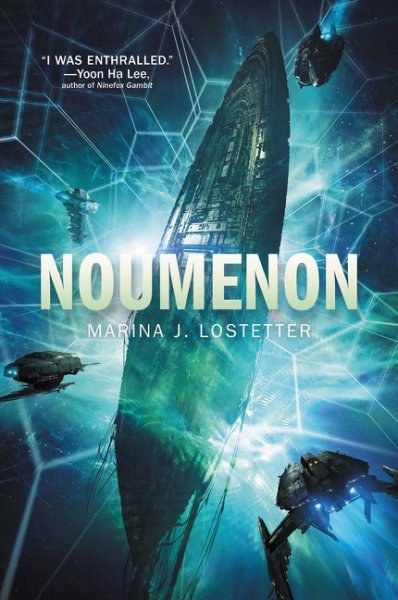Muscle and Blood and Skin and Bones
Noumenon
By Marina J. Lostetter

14 Oct, 2017
2017’s Noumenon is a standalone generation-ship epic from Marina J. Lostetter.
Reggie Straifer is twice lucky. First, he has boosted his career with his discovery of an enigmatic stellar object, one that is quite possibly artificial. Second, he has made his discovery at a time when humanity has both the means and the will to travel to that distant object.
There’s just one catch: the round trip will take two thousand years by Earth’s clocks and over two centuries by any traveller’s clock. Happily, the means and the will to deal with that issue also exist. Less happily, the means turns out to be inhumane.
Step one: sift the vast pool of volunteers for one hundred thousand people genetically predisposed to the behaviours essential to a stable community.
Step two: clone them and train the clones to serve in specific roles for the duration of their service lives. Install clones on ship and blast off.
Steps three to infinity: clone, clone, clone for almost three centuries, as the fleet of starships makes its way to the mysterious object and back.
What could go wrong? Well, yeah, there’s the wave of suicides at the beginning, as the first generation of clones realize that they are all trapped in steel bubbles for the rest of their lives. Then there are the clones who chafe at regimented lives followed by euthanasia when no longer useful. Followed by a mutiny. And an ominous silence from Earth.
All of this is capped by the challenge of determining the nature and purpose of the enigmatic structure around LQ Pyx.
~oOo~
When you see something that is technically sweet, you go ahead and do it and you argue about what to do about it only after you have had your technical success. That is the way it was with the atomic bomb.
—J. Robert Oppenheimer
With all due respect to the late Mr. Oppenheimer, the sequence of events leading up to the launch of the fleet doesn’t seem to make much sense. Why opt to make one of the very first missions such a long-range one? Why send squishy people when the means to send and communicate with a robot probe exist? Why pick the option that will not pay off for two thousand years when the same technology can produce more immediate results by facilitating a space telescope of prodigious ability?
But, given that they are going to send a generation ship, the architects of the mission tried to avoid one of the errors described in the SF they had certainly read. No volunteers to become disillusioned: it’s clone draftees all the way down.
On the plus side, the Plan works. The fleet does not end up a cannibal-filled derelict in deep space. But it works at the cost of consigning a hundred thousand people and their replacements to confinement and a brutal caste system for over two centuries. Ah well. Eggs, omelettes. Isn’t knowledge worth an enormous price in human suffering?
Because the novel has to cover almost one year per page, there’s not a lot of time for character development. Each mayfly gets their brief story and then dies, having served their narrative purpose. The unifying perspective is that of the I.C.C., the ship’s artificial intelligence. Not human but definitely intelligent, it falls to the single immortal on board to protect its charges as best it can and to comport itself with more compassion than the people who put this mission together.
My tendency to focus on set and props has betrayed me. I am too distracted by questions like “is this a reasonable use of this technology?” to enjoy the family saga (of sorts) the author has painted. Readers with different priorities may enjoy it more.
Noumenon is available here (Amazon) and here (Chapters-Indigo).
